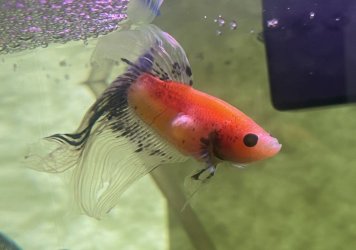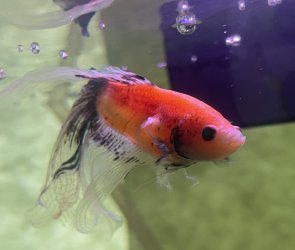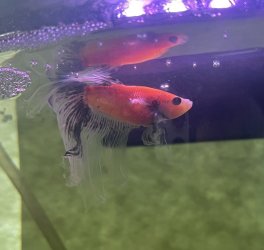Fish don't get constipated. That is a terrestrial animal thing caused by lack of fiber and lack of water.
------------------
Swim bladder problems cause fish to float or sink as soon as they stop swimming. If a fish floats to the surface after it stops swimming it can be air trapped in the fish's intestine or a swim bladder problem. Normally it's air from eating dry food from the surface. The fish swallows air and it builds up in the intestine and causes the fish to float around. If this is suspected, stop feeding dry food for a week and use live or frozen foods instead. If the problem rectifies itself, then the issue was air in the intestine, not the swim bladder.
If a fish sinks to the bottom as soon as it stops swimming, then it has a swim bladder problem. The exception to this rule is bottom dwelling fishes that don't have a swim bladder. There is no cure for swim bladder issues.
------------------
Dropsy is normally caused by a build up of fluid inside the fish. This is usually caused by an internal bacterial infection or internal organ damage caused by an injury or infection. Typical symptoms include the fish swelling up overnight and the scales sometimes stick out from the body. Fish stops eating and does a stringy white poop. Fish will often gasp at the surface or near a filter outlet.
There's not normally any cure for fish that show these symptoms because there is normally major organ damage and the fish is dying. Antibiotics sometimes work but not that often.
------------------
The lump on the side of the fish appears to be from something growing inside the fish and pushing outwards. If it has taken a few months to get to this stage, it is a slow growing tumour. If it grew in a couple of weeks it could be a fast growing tumour of cyst. If it occurred in a few days it is probably a bacterial infection. There's no cure for tumours or cysts in fish.
If the fish is eating well and not doing a stringy white poop, then it is unlikely to be a minor bacterial infection that can be treated. You can try salt or a broad spectrum fish medication (not antibiotics) that treats fungus and bacteria. But you might just have to wait and when the fish can't swim properly, or stops eating, then euthanise it.
------------------
SALT
You can add rock salt (often sold as aquarium salt) or swimming pool salt to the aquarium at the dose rate of 1 heaped tablespoon per 20 litres of water. If there is no improvement after 48 hours you can double that dose rate so there is 2 heaped tablespoons of salt per 20 litres.
Keep the salt level like this for at least 2 weeks but no longer than 4 weeks otherwise kidney damage can occur. Kidney damage is more likely to occur in fish from soft water (tetras, Corydoras, angelfish, Bettas & gouramis, loaches) that are exposed to high levels of salt for an extended period of time, and is not an issue with livebearers, rainbowfish or other salt tolerant species.
The salt will not affect the beneficial filter bacteria, fish, plants, shrimp or snails.
After you use salt and the fish have recovered, you do a 10% water change each day for a week using only fresh water that has been dechlorinated. Then do a 20% water change each day for a week. Then you can do bigger water changes after that. This dilutes the salt out of the tank slowly so it doesn't harm the fish.
If you do water changes while using salt, you need to treat the new water with salt before adding it to the tank. This will keep the salt level stable in the tank and minimise stress on the fish.
When you first add salt, add the salt to a small bucket of tank water and dissolve the salt. Then slowly pour the salt water into the tank near the filter outlet. Add the salt over a couple of minutes.




